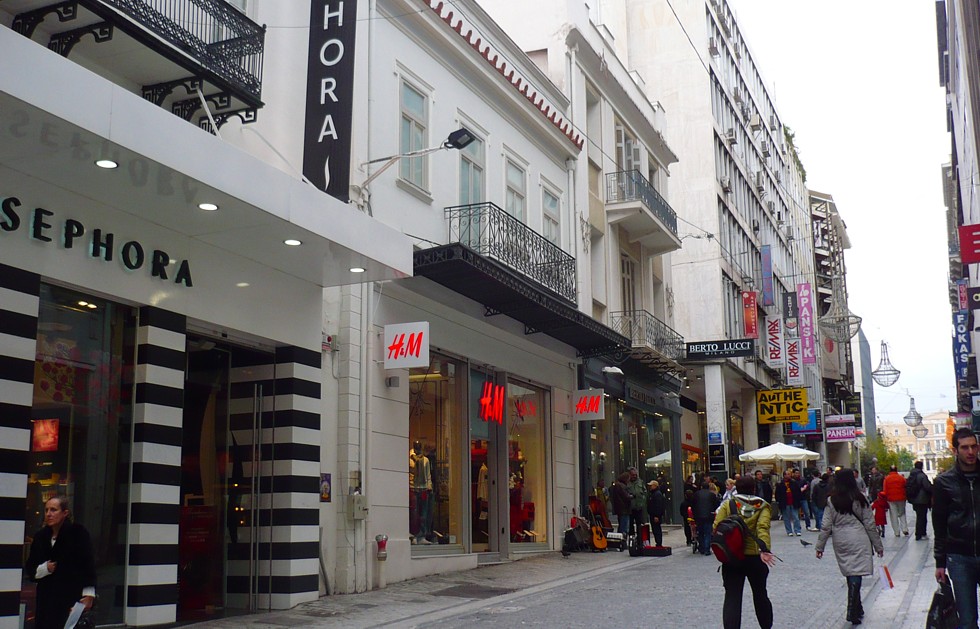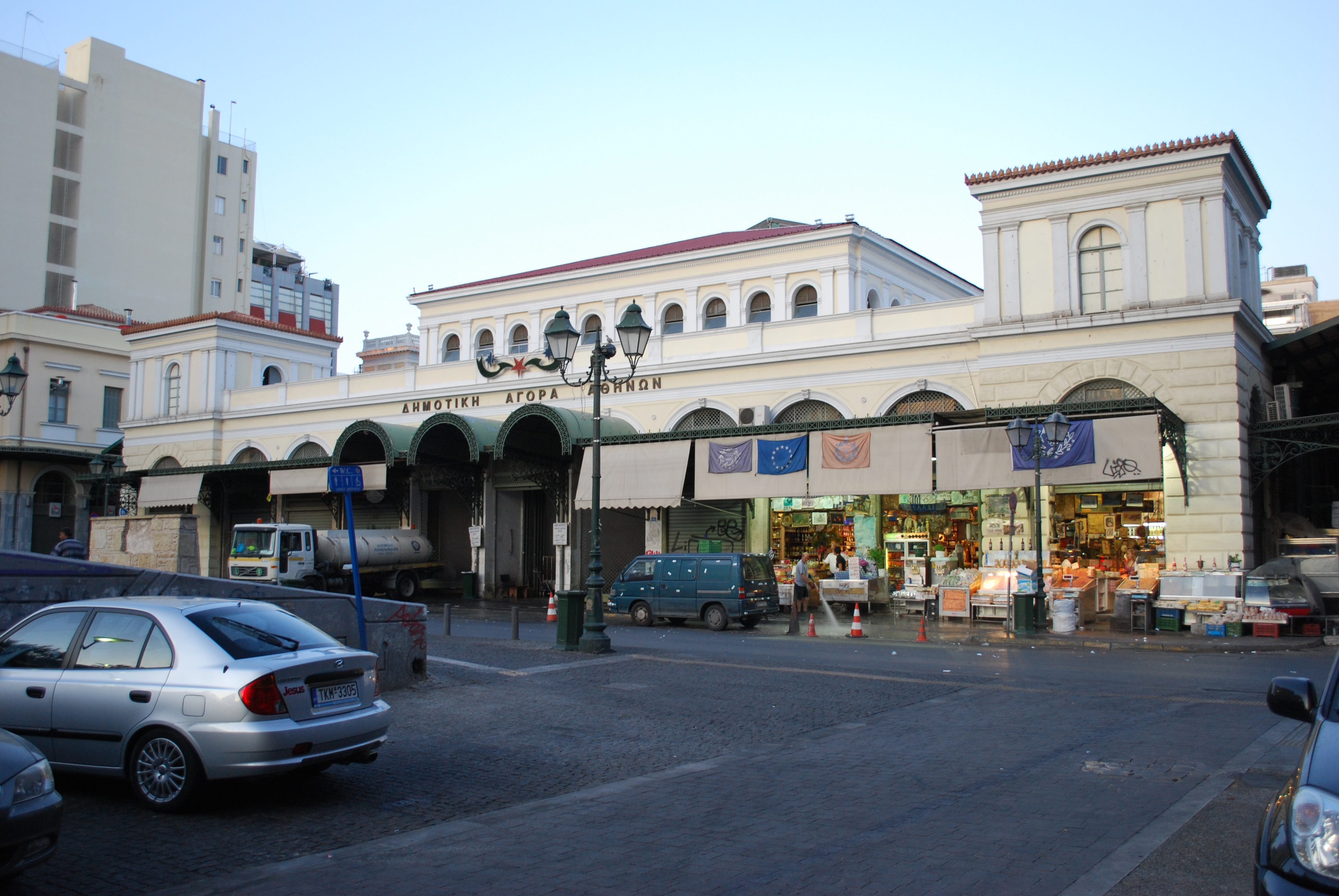|
Ermou Street (Athens)
Ermou Street ( el, Οδός Ερμού, ''Odos Ermou'', "Hermes Street") is a one and a half kilometer-long road in central Athens, Greece, connecting Kerameikos archaeological site with the Syntagma Square through Monastiraki, Psiri and Thiseio. It consists of three sections: The east (from Filellinon Street to Aiolou Street, app. 700m long) which is a pedestrian zone and the city's best-known and busiest shopping street, the middle (from Aiolou Street to Agion Asomaton str.) and the west (from Agion Asomaton to Peiraios Street) a pedestrian zone also. With fashion shops and shopping centres promoting most international brands, it is in the top five most expensive shopping streets in Europe, and the tenth most expensive retail street in the world. Nearby, the renovated Army Fund building in Panepistimiou Street includes the "Attica" department store and several upmarket designer stores. One of the oldest churches in Athens, the Byzantine Church of Panaghia Kapnikarea is in a ... [...More Info...] [...Related Items...] OR: [Wikipedia] [Google] [Baidu] |
Kapnikarea
The Church of Panagia Kapnikarea ( el, Εκκλησία της Παναγίας Καπνικαρέας) or just Kapnikarea (Greek: Καπνικαρέα) is a Greek Orthodox church and one of the oldest churches in Athens. History It is estimated that the church was built some time in the 11th century, perhaps around 1050. As it was common with the early Christian churches, this was built over an ancient Greek temple dedicated to the worship of a goddess, possibly Athena or Demeter. When King Otto I, King of the Kingdom of Greece, brought the Bavarian architect Leo von Klenze to draw the new city plan of Athens, the church was considered for demolition and it was the King of Bavaria, Ludwig I who objected the decision and saved the church. Architecture It appears that the Kapnikarea church may have originally been the '' katholikon'' of a monastery. Presently, the building is formed by a complex of three different units attached together; these units were built in succession ... [...More Info...] [...Related Items...] OR: [Wikipedia] [Google] [Baidu] |
Athinas Street
Athinas Street ( el, Οδός Αθηνάς) is a street in downtown Athens in Greece. It is named after Athena, the goddess of wisdom. The street runs from Ermou Street north to Omonoia Square through the Psiri neighborhood. Its total length is nearly 1 km of which 80 m is a walkway since 1999. Until 1999, it used to access with Omonoia Square, now motorists can now access it via Lykourgos Street east to Aiolou and 28 Oktovriou (Patissi) Street and other streets. North of Lykourgos is a pedestrian walkway. It has two lanes of traffic and room for curb parking. Famous buildings includes the Athens City Hall on the west side and office towers northward. The Modern Agora is east of Athinas Street. Kotzia Square lies to the east with Karamanou Square also on the east. Shops and residential buildings lies to the south with neo-classical buildings. In the middle of Athinas street is the Varvakeios municipal market. The oldest market in Athens The rest of the arch ... [...More Info...] [...Related Items...] OR: [Wikipedia] [Google] [Baidu] |
Panathinaiko Stadium
The Panathenaic Stadium ( el, Παναθηναϊκό Στάδιο, Panathinaïkó Stádio, ), as spelled by Philostratus. or ''Kallimarmaro'' (Καλλιμάρμαρο, , lit. "beautiful marble") is a multi-purpose stadium in Athens, Greece. One of the main historic attractions of Athens, it is the only stadium in the world built entirely of marble. A stadium was built on the site of a simple racecourse by the Athenian statesman Lykourgos (Lycurgus) BC, primarily for the Panathenaic Games. It was rebuilt in marble by Herodes Atticus, an Athenian Roman senator, by 144 AD it had a capacity of 50,000 seats. After the rise of Christianity in the 4th century it was largely abandoned. The stadium was excavated in 1869 and hosted the Zappas Olympics in 1870 and 1875. After being refurbished, it hosted the opening and closing ceremonies of the first modern Olympics in 1896 and was the venue for 4 of the 9 contested sports. It was used for various purposes in the 20th century and was ... [...More Info...] [...Related Items...] OR: [Wikipedia] [Google] [Baidu] |
Wholesale
Wholesaling or distributing is the sale of goods or merchandise to retailers; to industrial, commercial, institutional or other professional business users; or to other wholesalers (wholesale businesses) and related subordinated services. In general, it is the sale of goods in bulk to anyone, either a person or an organization, other than the end consumer of that merchandise. Wholesaling is buying goods in bulk quantity, usually directly from the manufacture or source, at a discounted rate. The retailer then sells the goods to the end consumer at a higher price making a profit. According to the United Nations Statistics Division, ''wholesale'' is the resale of new and used goods to retailers, to industrial, commercial, institutional or professional users, or to other wholesalers, or involves acting as an agent or broker in buying merchandise for, or selling merchandise to, such persons or companies. Wholesalers frequently physically assemble, sort, and grade goods in large lo ... [...More Info...] [...Related Items...] OR: [Wikipedia] [Google] [Baidu] |
Athens News Agency
The Athens News Agency (ANA; el, Αθηναϊκό Πρακτορείο Ειδήσεων) was one of the two major news agencies in Greece, the other being the Macedonian Press Agency, before they merged into the Athens-Macedonian News Agency (AMNA). History The Athens News Agency (ANA) is the national news agency of Greece. Founded in 1895 as a private company, the Stefanopoli Telegraphic Agency, the Greek State assumed its subsidisation in 1905, at which time it acquired its present name. In 1994 the ANA became a Societe Anonyme with a 7-member Board of Directors, three of whom are appointed by the government and one each by the journalist unions of Athens and Thessaloniki, the publishers' union and the ANA employees. ANA collaborates with the international news agencies Reuters, Agence France-Presse, DPA, TASS and a number of national news agencies, as well as the EPA photograph agency. All the ANA services are on-line, with an estimated 350 news items in Greek and 60-70 ite ... [...More Info...] [...Related Items...] OR: [Wikipedia] [Google] [Baidu] |
Rizospastis
''Rizospastis'' ( el, Ριζοσπάστης, "The Radical") is the official newspaper of the Communist Party of Greece. It has been published daily since its first issue in 1916. Liana Kanelli is currently one of the senior editors of the newspaper. Motto "Organ of the Communist Party's Central Committee" and "Proletarians of all countries unite!" See also *Nikos Boyiopoulos References External links * Publications established in 1916 1916 establishments in Greece Greek-language newspapers Newspapers published in Athens Communist newspapers Communist Party of Greece Daily newspapers published in Greece {{Greece-newspaper-stub ... [...More Info...] [...Related Items...] OR: [Wikipedia] [Google] [Baidu] |
Retail Trade
Retail is the sale of goods and services to consumers, in contrast to wholesaling, which is sale to business or institutional customers. A retailer purchases goods in large quantities from manufacturers, directly or through a wholesaler, and then sells in smaller quantities to consumers for a profit. Retailers are the final link in the supply chain from producers to consumers. Retail markets and shops have a very ancient history, dating back to antiquity. Some of the earliest retailers were itinerant peddlers. Over the centuries, retail shops were transformed from little more than "rude booths" to the sophisticated shopping malls of the modern era. In the digital age, an increasing number of retailers are seeking to reach broader markets by selling through multiple channels, including both bricks and mortar and online retailing. Digital technologies are also affecting the way that consumers pay for goods and services. Retailing support services may also include the provision ... [...More Info...] [...Related Items...] OR: [Wikipedia] [Google] [Baidu] |
Eduard Schaubert
Gustav Eduard Schaubert ( el, Εδουάρδος Σάουμπερτ, translit=Edouárdos Sáoumpert) 27 July 1804, Breslau, Kingdom of Prussia, Prussia – 30 March 1860, Breslau) was a Prussian architect, who made a major contribution to the re-planning of Athens after the Greek War of Independence. Life Urban planner Schaubert studied in Breslau and at the Bauakademie in Berlin, where he was a pupil of Karl Friedrich Schinkel and studied alongside Stamatios Kleanthis. Schaubert and Kleanthis were among the pioneers of nineteenth century urban redevelopment in Greece. After studying in Berlin they began their architectural careers in Athens under Ioannis Kapodistrias, producing a highly detailed topographical plan of Athens' ancient ruins, Byzantine churches and the buildings of the old city in 1831. This plan became the foundation of the building of a modern capital for the new Kingdom of Greece, expanding it in a triangle to the north of the Acropolis of Athens, Acropolis ... [...More Info...] [...Related Items...] OR: [Wikipedia] [Google] [Baidu] |
Stamatios Kleanthis
Stamatios or Stamatis Kleanthis ( el, Σταμάτιος or ; 1802–1862) was a Greek architect. Biography Stamatios Kleanthis was born to a Macedonian Greek family in the town of Velventos in Kozani, Macedonia in 1802. As a youth he moved to Bucharest where he studied at the Greek School. On 1821, as member of the Sacred Band, he fought in the insurrection against the Turks led by Alexander Ypsilanti and was captured at the Battle of Dragashani. After escaping, he traveled to Vienna, and then to Leipzig, where he studied architecture. Afterwards he pursued his studies further in Berlin with Karl Friedrich Schinkel. After graduation, he returned with his colleague and friend Eduard Schaubert to Greece, where they were appointed public engineers by Ioannis Kapodistrias. On 1832 they created a new city plan for Athens, which included wide avenues, gardens and grand public buildings and gave the first street names in Athens. The plan was however simplified by Leo von Klenze, as ... [...More Info...] [...Related Items...] OR: [Wikipedia] [Google] [Baidu] |
Sister City
A sister city or a twin town relationship is a form of legal or social agreement between two geographically and politically distinct localities for the purpose of promoting cultural and commercial ties. While there are early examples of international links between municipalities akin to what are known as sister cities or twin towns today dating back to the 9th century, the modern concept was first established and adopted worldwide during World War II. Origins of the modern concept The modern concept of town twinning has its roots in the Second World War. More specifically, it was inspired by the bombing of Coventry on 14 November 1940, known as the Coventry Blitz. First conceived by the then Mayor of Coventry, Alfred Robert Grindlay, culminating in his renowned telegram to the people of Stalingrad (now Volgograd) in 1942, the idea emerged as a way of establishing solidarity links between cities in allied countries that went through similar devastating events. The comradesh ... [...More Info...] [...Related Items...] OR: [Wikipedia] [Google] [Baidu] |





.jpg)